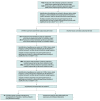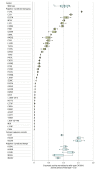Association of Rare CYP39A1 Variants With Exfoliation Syndrome Involving the Anterior Chamber of the Eye
- PMID: 33620406
- PMCID: PMC7903258
- DOI: 10.1001/jama.2021.0507
Association of Rare CYP39A1 Variants With Exfoliation Syndrome Involving the Anterior Chamber of the Eye
Erratum in
-
Two Incomplete Author Names.JAMA. 2021 Apr 6;325(13):1335. doi: 10.1001/jama.2021.3920. JAMA. 2021. PMID: 33821917 Free PMC article. No abstract available.
Abstract
Importance: Exfoliation syndrome is a systemic disorder characterized by progressive accumulation of abnormal fibrillar protein aggregates manifesting clinically in the anterior chamber of the eye. This disorder is the most commonly known cause of glaucoma and a major cause of irreversible blindness.
Objective: To determine if exfoliation syndrome is associated with rare, protein-changing variants predicted to impair protein function.
Design, setting, and participants: A 2-stage, case-control, whole-exome sequencing association study with a discovery cohort and 2 independently ascertained validation cohorts. Study participants from 14 countries were enrolled between February 1999 and December 2019. The date of last clinical follow-up was December 2019. Affected individuals had exfoliation material on anterior segment structures of at least 1 eye as visualized by slit lamp examination. Unaffected individuals had no signs of exfoliation syndrome.
Exposures: Rare, coding-sequence genetic variants predicted to be damaging by bioinformatic algorithms trained to recognize alterations that impair protein function.
Main outcomes and measures: The primary outcome was the presence of exfoliation syndrome. Exome-wide significance for detected variants was defined as P < 2.5 × 10-6. The secondary outcomes included biochemical enzymatic assays and gene expression analyses.
Results: The discovery cohort included 4028 participants with exfoliation syndrome (median age, 78 years [interquartile range, 73-83 years]; 2377 [59.0%] women) and 5638 participants without exfoliation syndrome (median age, 72 years [interquartile range, 65-78 years]; 3159 [56.0%] women). In the discovery cohort, persons with exfoliation syndrome, compared with those without exfoliation syndrome, were significantly more likely to carry damaging CYP39A1 variants (1.3% vs 0.30%, respectively; odds ratio, 3.55 [95% CI, 2.07-6.10]; P = 6.1 × 10-7). This outcome was validated in 2 independent cohorts. The first validation cohort included 2337 individuals with exfoliation syndrome (median age, 74 years; 1132 women; n = 1934 with demographic data) and 2813 individuals without exfoliation syndrome (median age, 72 years; 1287 women; n = 2421 with demographic data). The second validation cohort included 1663 individuals with exfoliation syndrome (median age, 75 years; 587 women; n = 1064 with demographic data) and 3962 individuals without exfoliation syndrome (median age, 74 years; 951 women; n = 1555 with demographic data). Of the individuals from both validation cohorts, 5.2% with exfoliation syndrome carried CYP39A1 damaging alleles vs 3.1% without exfoliation syndrome (odds ratio, 1.82 [95% CI, 1.47-2.26]; P < .001). Biochemical assays classified 34 of 42 damaging CYP39A1 alleles as functionally deficient (median reduction in enzymatic activity compared with wild-type CYP39A1, 94.4% [interquartile range, 78.7%-98.2%] for the 34 deficient variants). CYP39A1 transcript expression was 47% lower (95% CI, 30%-64% lower; P < .001) in ciliary body tissues from individuals with exfoliation syndrome compared with individuals without exfoliation syndrome.
Conclusions and relevance: In this whole-exome sequencing case-control study, presence of exfoliation syndrome was significantly associated with carriage of functionally deficient CYP39A1 sequence variants. Further research is needed to understand the clinical implications of these findings.
Conflict of interest statement
Figures





References
Publication types
MeSH terms
Substances
Grants and funding
LinkOut - more resources
Full Text Sources
Other Literature Sources
Molecular Biology Databases

